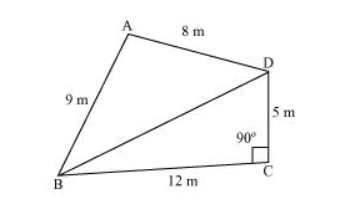Question.
A park, in the shape of a quadrilateral ABCD, has ∠C = 90°, AB = 9 m, BC = 12 m, CD = 5 m and AD = 8 m. How much area does it occupy?
Solution:
Let us join BD.
In $\triangle B C D$, applying Pythagoras theorem,
$B D^{2}=B C^{2}+C D^{2}$
$=(12)^{2}+(5)^{2}$
$=144+25$
$B D^{2}=169$
$B D=13 \mathrm{~m}$

Area of $\triangle B C D=\frac{1}{2} \times B C \times C D=\left(\frac{1}{2} \times 12 \times 5\right) \mathrm{m}^{2}=30 \mathrm{~m}^{2}$
For $\triangle \mathrm{ABD}$,
$s=\frac{\text { Perimeter }}{2}=\frac{(9+8+13) \mathrm{m}}{2}=15 \mathrm{~m}$
By Heron's formula,
Area of triangle $=\sqrt{s(s-a)(s-b)(s-c)}$
Area of $\triangle \mathrm{ABD}=[\sqrt{15(15-9)(15-8)(15-13)}] \mathrm{m}^{2}$
$=(\sqrt{15 \times 6 \times 7 \times 2}) \mathrm{m}^{2}$
$=6 \sqrt{35} \mathrm{~m}^{2}$
$=(6 \times 5.916) \mathrm{m}^{2}$
$=35.496 \mathrm{~m}^{2}$
Area of the park $=$ Area of $\triangle \mathrm{ABD}+$ Area of $\triangle \mathrm{BCD}$
$=35.496+30 \mathrm{~m}^{2}=65.496 \mathrm{~m}^{2}=65.5 \mathrm{~m}^{2}$ (approximately)
Let us join BD.
In $\triangle B C D$, applying Pythagoras theorem,
$B D^{2}=B C^{2}+C D^{2}$
$=(12)^{2}+(5)^{2}$
$=144+25$
$B D^{2}=169$
$B D=13 \mathrm{~m}$

Area of $\triangle B C D=\frac{1}{2} \times B C \times C D=\left(\frac{1}{2} \times 12 \times 5\right) \mathrm{m}^{2}=30 \mathrm{~m}^{2}$
For $\triangle \mathrm{ABD}$,
$s=\frac{\text { Perimeter }}{2}=\frac{(9+8+13) \mathrm{m}}{2}=15 \mathrm{~m}$
By Heron's formula,
Area of triangle $=\sqrt{s(s-a)(s-b)(s-c)}$
Area of $\triangle \mathrm{ABD}=[\sqrt{15(15-9)(15-8)(15-13)}] \mathrm{m}^{2}$
$=(\sqrt{15 \times 6 \times 7 \times 2}) \mathrm{m}^{2}$
$=6 \sqrt{35} \mathrm{~m}^{2}$
$=(6 \times 5.916) \mathrm{m}^{2}$
$=35.496 \mathrm{~m}^{2}$
Area of the park $=$ Area of $\triangle \mathrm{ABD}+$ Area of $\triangle \mathrm{BCD}$
$=35.496+30 \mathrm{~m}^{2}=65.496 \mathrm{~m}^{2}=65.5 \mathrm{~m}^{2}$ (approximately)
Click here to get exam-ready with eSaral
For making your preparation journey smoother of JEE, NEET and Class 8 to 10, grab our app now.
